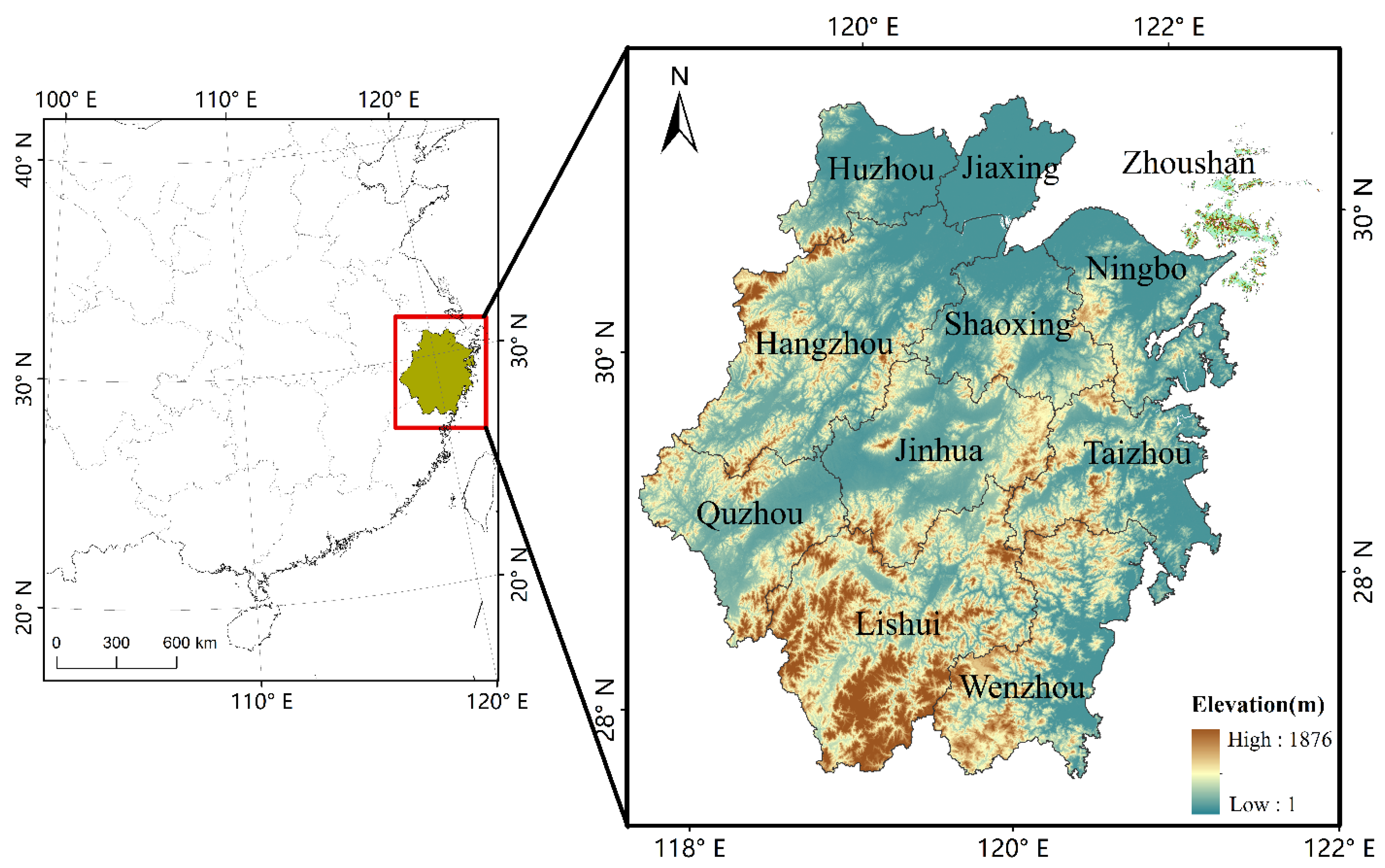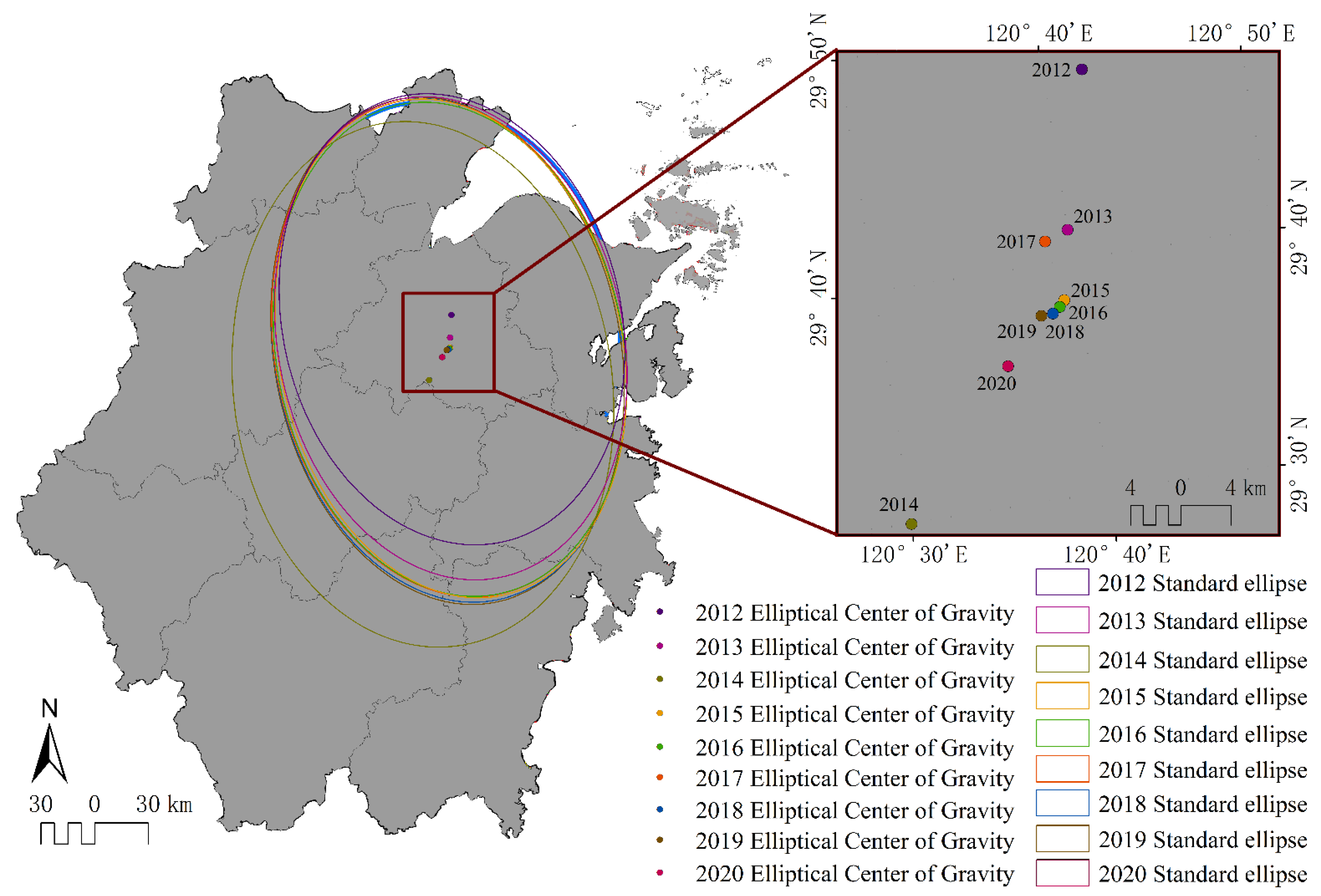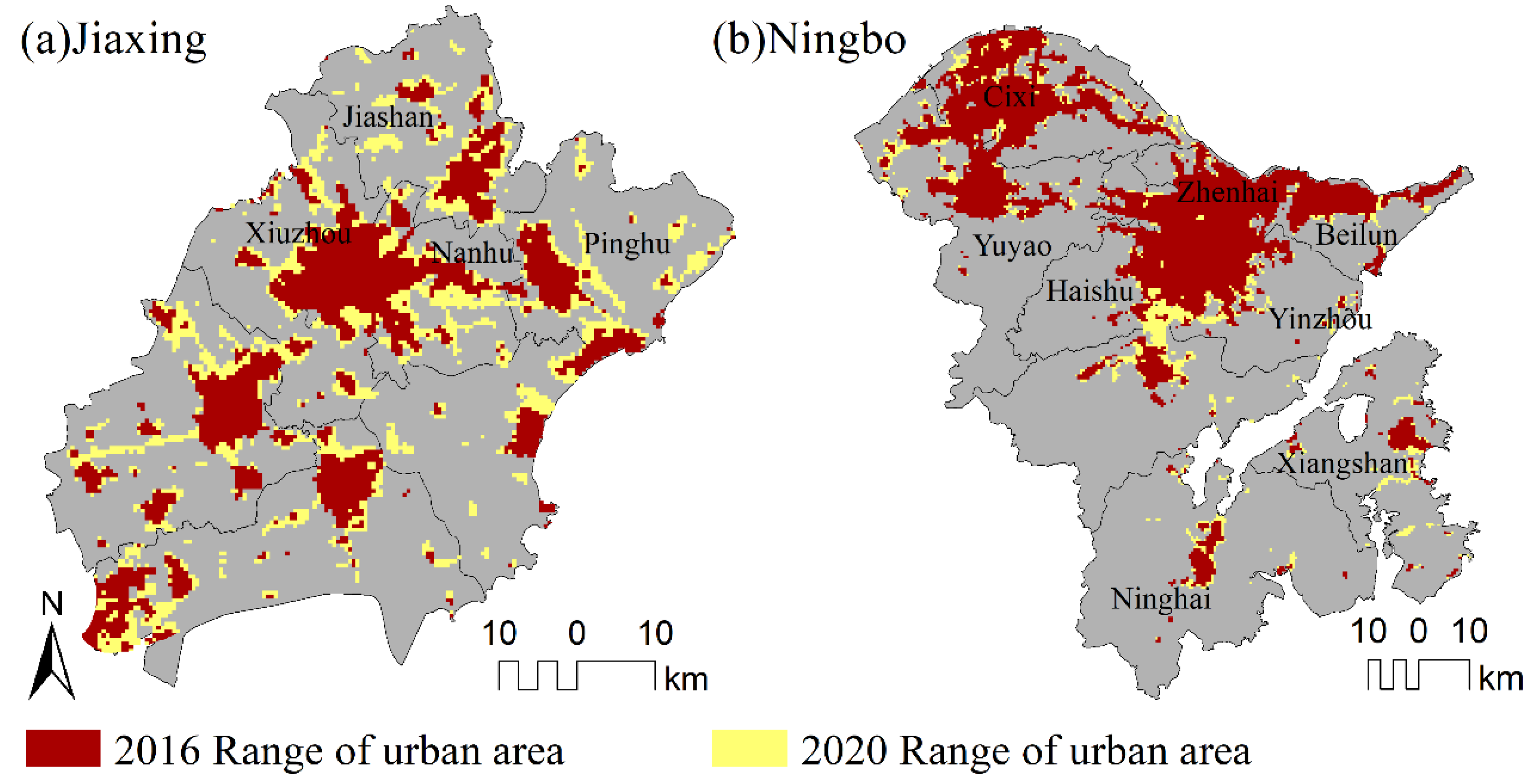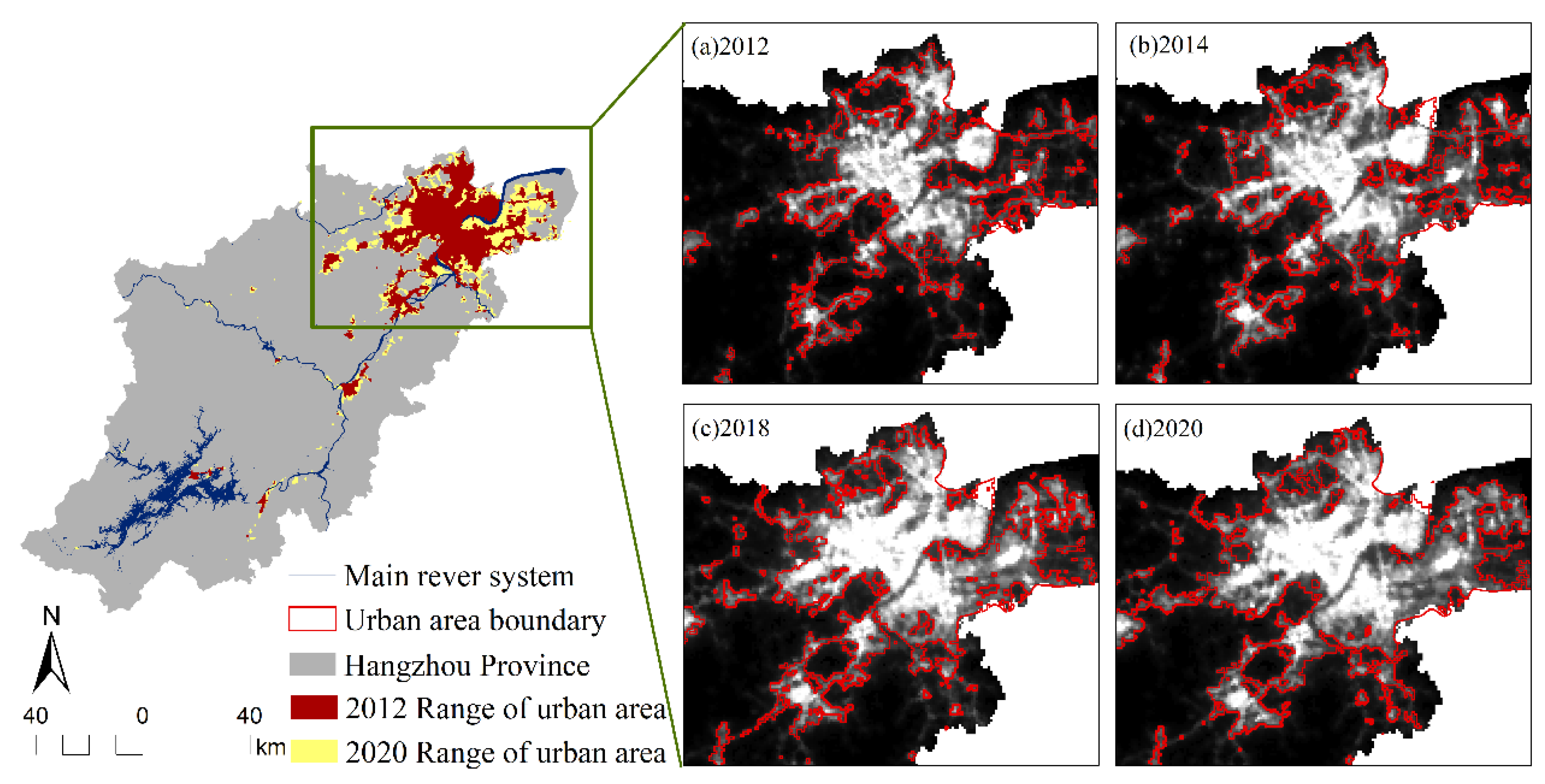Analyzing the Dynamic Spatiotemporal Changes in Urban Extension across Zhejiang Province Using NPP-VIIRS Nighttime Light Data
Abstract
:1. Introduction
2. Study Area and Data
2.1. Study Area
2.2. Data Source
- (1)
- Nighttime light data
- (2)
- Global urban boundaries derived from GAIA data
- (3)
- Google Earth data
- (4)
- Administrative division data
2.3. Data Preprocessing
3. Methodology
3.1. Urban Area Extraction Based on Buffer Threshold Analysis
3.2. Urban Scale and Morphology Indicators
- (1)
- Total nighttime light value
- (2)
- Standard deviation ellipse
3.3. Indicators of Urban Structure Characteristics
- (1)
- Dual-core primacy
- (2)
- Urban-scale Gini index
4. Results and Discussion
4.1. Changes Detection in the Total Nighttime Light Value
4.1.1. Interannual Variations in the Total Nighttime Light Value Zhejiang Province Cities
4.1.2. Spatial Variations in Nighttime Light in Zhejiang Province
- (1)
- Standard deviation ellipse and change in the center of gravity of nighttime light
- (2)
- Spatial and temporal nighttime light variations in major cities
4.2. Urban Structure Analysis Based on the Total Nighttime Light Value
4.2.1. “Dual-Core” Primacy
4.2.2. Urban-Scale Gini Index
5. Conclusions
Author Contributions
Funding
Data Availability Statement
Acknowledgments
Conflicts of Interest
References
- Hu, J. Firmly march on the path of socialism with Chinese characteristics and strive to complete the building of a moderately prosperous society in all respects–Report to the 18th National Congress of the Chinese Communist Party. Qiushi 2012, 22, 3–25. [Google Scholar]
- Fang, C. Basic rules and key paths for high-quality development of the new urbanization in China. Geogr. Res. 2019, 38, 13–22. [Google Scholar]
- Zhejiang Provincial Development and Reform Commission and Ministry of Housing and Urban-Rural Development of Zhejiang Province. The 14th Five-Year Plan for New Urbanization Development of Zhejiang; Zhejiang Provincial Development and Reform Commission and Ministry of Housing and Urban-Rural Development of Zhejiang Province: Zhejiang, China, 2021. (In Chinese)
- World Urbanization Prospects: 2018 Revision. United Nations Population Division. Available online: https://data.worldbank.org/indicator/SP.URB.TOTL.IN.ZS (accessed on 6 January 2022).
- Ye, L. Evaluation of urban development quality based on the connotation of high-quality development: A case study of guangdong province. J. Landsc. Res. 2019, 11, 83–89. [Google Scholar]
- Zhu, B.; Zhang, M.; Zhou, Y.; Wang, P.; Sheng, J.; He, K.; Wei, Y.-M.; Xie, R. Exploring the effect of industrial structure ad-justment on interprovincial green development efficiency in China: A novel integrated approach. Energy Policy 2019, 134, 110946. [Google Scholar] [CrossRef]
- Mei, A. An Introduction to Remote Sensing; Higher Education Press: Beijing, China, 2001. [Google Scholar]
- Carter, H. The Study of Urban Geography; A Hodder Arnold Publication: London, UK, 1995. [Google Scholar]
- Chen, Z. A Multiscale Analysis on Urban Area and Spatial Structure Based on Nighttime Light Data. Ph.D. Thesis, East China Normal University, Shanghai, China, 2017. [Google Scholar]
- Liu, Y.; Jieyong, W.; Zhiwei, W. Simulation of the Spatial Pattern of Population of Urban and Rural Residents in Huang-Huai-Hai Area Based on NPP/VIIRS Nighttime Lights. Areal Res. Dev. 2019, 38, 176–180. [Google Scholar]
- Zhu, Z.; Xiang, X.; Shuangshuang, L. Evolution process and characteristics of spatial structure of urban agglomeration in the middle reaches of the Yangtze River. Acta Geogr. Sin. 2021, 76, 799–817. [Google Scholar]
- He, Q. Research on Digital Observation and Spatial Model Construction of Multi-Dimensional Urban Nighttime Light Environment. Master’s Thesis, Dalian University of Technology, Dalian, China, 2019. [Google Scholar]
- Xu, M.; He, C.; Liu, Z.; Dou, Y. How did urban land expand in china between 1992 and 2015? A multi-scalelandscape analysis. PLoS ONE 2016, 11, e0154839. [Google Scholar]
- Waluda, C.M.; Griffiths, H.J.; Rodhouse, P.G. Remotely sensed spatial dynamics of the Illex argentinus fishery, Southwest Atlantic. Fish. Res. 2008, 91, 196–202. [Google Scholar] [CrossRef]
- Imhoff, M.L.; Lawrence, W.T.; Stutzer, D.C.; Elvidge, C.D. A technique for using composite DMSP/OLS ‘City lights’ satellite data to map urban area. Remote Sens. Environ. 1997, 61, 361–370. [Google Scholar] [CrossRef]
- Li, Y.; Song, Z.; Wu, B.; Yu, B.; Wu, Q.; Hong, Y.; Liu, S.; Wu, J. Evaluating the Ability of NOAA-20 Monthly Composite Data for Socioeconomic Indicators Estimation and Urban Area Extraction. IEEE J. Sel. Top. Appl. Earth Obs. Remote Sens. 2022, 15, 1837–1845. [Google Scholar] [CrossRef]
- Zhou, Y.; Smith, S.J.; Elvidge, C.D.; Zhao, K.; Thomson, A.; Imhoff, M. A cluster-based method to map urban area from DMSP/OLS nightlights. Remote Sens. Environ. 2014, 147, 173–185. [Google Scholar] [CrossRef]
- Chen, Z.; Yu, B.; Song, W.; Liu, H.; Wu, Q.; Shi, K.; Wu, J. A New Approach for Detecting Urban Centers and Their Spatial Structure With Nighttime Light Remote Sensing. IEEE Trans. Geosci. Remote Sens. 2017, 55, 6305–6319. [Google Scholar] [CrossRef]
- Wu, B.; Yu, B.; Yao, S.; Wu, Q.; Chen, Z.; Wu, J. A surface network based method for studying urban hierarchies by night time light remote sensing data. Int. J. Geogr. Inf. Sci. 2019, 33, 1377–1398. [Google Scholar] [CrossRef]
- Li, D.; Yu, H.; Li, X. The Spatial-Temporal Pattern Analysis of City Development in Countries along the Belt and Road Initiative Based on Nighttime Light Data. Geomat. Inf. Sci. Wuhan Univ. 2017, 42, 711–720. [Google Scholar]
- Xu, H.; Hu, S. Chinese City Size Evolution Under Perspective of Nighttime Light Remote Sensing. Geomat. Inf. Sci. Wuhan Univ. 2021, 46, 40–49. [Google Scholar]
- Zheng, W.; Kuang, A.; Liu, Z.; Wang, X. Analysing the spatial structure of urban growth across the Yangtze River Middle reaches urban agglomeration in China using NPP-VIIRS night-time lights data. Geo J. 2021, 1–18. [Google Scholar] [CrossRef]
- Shi, K.; Huang, C.; Yu, B.; Yin, B.; Huang, Y.; Wu, J. Evaluation of NPP-VIIRS night-time light composite data for extracting built-up urban areas. Remote Sens. Lett. 2014, 5, 358–366. [Google Scholar] [CrossRef]
- Ma, T.; Zhou, C.; Pei, T.; Haynie, S.; Fan, J. Responses of Suomi-NPP VIIRS-derived nighttime lights to socioeconomic activity in China’s cities. Remote Sens. Lett. 2014, 5, 165–174. [Google Scholar] [CrossRef]
- Elvidge, C.D.; Zhizhin, M.; Ghosh, T.; Hsu, F.-C.; Taneja, J. Annual Time Series of Global VIIRS Nighttime Lights Derived from Monthly Averages: 2012 to 2019. Remote Sens. 2021, 13, 922. [Google Scholar] [CrossRef]
- Elvidge, C.D.; Baugh, K.; Zhizhin, M.; Hsu, F.C.; Ghosh, T. VIIRS night-time lights. Int. J. Remote Sens. 2017, 38, 5860–5879. [Google Scholar] [CrossRef]
- Xie, Y.; Weng, Q. Updating urban extents with nighttime light imagery by using an object-based thresholding method. Remote Sens. Environ. 2016, 187, 1–13. [Google Scholar] [CrossRef]
- Srivastava, A.; Bharadwaj, S.; Dubey, R.; Sharma, V.B.; Biswas, S. Mapping Vegetation and Measuring the Performance of Machine Learning Algorithm in Lulc Classification in the Large Area Using Sentinel-2 and Landsat-8 Datasets of Dehradun as a Test Case. Int. Arch. Photogramm. Remote Sens. Spat. Inf. Sci. 2022, 43, 529–535. [Google Scholar] [CrossRef]
- Jefferson, M. The Law of the Primate City. Geogr. Rev. 1939, 29, 226–232. [Google Scholar] [CrossRef]
- He, C.; Shi, P.; Li, J.; Chen, J.; Pan, Y.; Li, J.; Zhuo, L.; Ichinose, T. Spatial Reconstruction of Urbanization Processes in Mainland China in the 1990s Based on DMSP/OLS Nighttime Lighting Data and Statistics. Chin. Sci. Bull. 2006, 7, 856–861. [Google Scholar]
- Chen, X.; Li, X.; Qiu, Z.; Jiang, D. A Gini Coefficient -Based Equilibrium Study for the Distribution of City Size. Stat. Decis. 2017, 1, 93–97. [Google Scholar]
- Zhang, H.; Ye, Y.; Chen, S. The changes of population size hierarchy of the urban group of pearl river delta and its spatial character since 20 years ago. Econ. Geograpgy 2006, 26, 806–809. [Google Scholar]
- Xu, P.; Jin, P.; Yang, Y.; Wang, Q. Evaluating Urbanization and Spatial-Temporal Pattern Using the DMSP/OLS Nighttime Light Data: A Case Study in Zhejiang Province. Math. Probl. Eng. 2016, 2016, 9850890. [Google Scholar] [CrossRef] [Green Version]
- Xu, P.; Jin, P.; Cheng, Q. Monitoring Regional Urban Dynamics Using DMSP/OLS Nighttime Light Data in Zhejiang Province. Math. Probl. Eng. 2020, 2020, 9652808. [Google Scholar] [CrossRef]
- Ningbo Municipal Bureau of Natural Resources and Planning. The Ningbo Urban Master Plan for 2006–2020 (2015 Revision); Ningbo Municipal Bureau of Natural Resources and Planning: Zhejiang, China, 2015. (In Chinese)
- Yi, J. Asian cities: Spatial dynamics and driving forces. Ann. Reg. Sci. 2021, 66, 609–654. [Google Scholar]
- Li, Y.; Ye, H.; Gao, X.; Sun, D.; Li, Z.; Zhang, N.; Leng, X.; Meng, D.; Zheng, J. Spatiotemporal Patterns of Urbanization in the Three Most Developed Urban Agglomerations in China Based on Continuous Nighttime Light Data (2000–2018). Remote Sens. 2021, 13, 2245. [Google Scholar] [CrossRef]









| Year | Urban Zone | Non-Urban Zone | Overall Accuracy | Kappa Coefficient | ||
|---|---|---|---|---|---|---|
| True | False | True | False | |||
| 2012 | 92 | 8 | 88 | 12 | 90.0% | 80.0% |
| 2013 | 88 | 12 | 93 | 7 | 90.5% | 81.0% |
| 2014 | 90 | 10 | 94 | 6 | 92.0% | 84.0% |
| 2015 | 90 | 10 | 91 | 9 | 90.5% | 81.0% |
| 2016 | 98 | 2 | 84 | 16 | 91.0% | 82.0% |
| 2017 | 96 | 4 | 95 | 5 | 95.5% | 91.0% |
| 2018 | 89 | 11 | 91 | 9 | 90.0% | 80.0% |
| 2019 | 95 | 5 | 90 | 10 | 92.5% | 85.0% |
| 2020 | 90 | 10 | 92 | 8 | 91.0% | 82.0% |
| Year | 2012 | 2013 | 2014 | 2015 | 2016 | 2017 | 2018 | 2019 | 2020 |
|---|---|---|---|---|---|---|---|---|---|
| Pr (“Dual-core” Primacy) | 3.35 | 2.67 | 2.49 | 2.40 | 2.36 | 2.26 | 2.12 | 2.04 | 2.01 |
| G (Urban-scale Gini index) | 0.24 | 0.28 | 0.21 | 0.20 | 0.20 | 0.20 | 0.19 | 0.18 | 0.21 |
Publisher’s Note: MDPI stays neutral with regard to jurisdictional claims in published maps and institutional affiliations. |
© 2022 by the authors. Licensee MDPI, Basel, Switzerland. This article is an open access article distributed under the terms and conditions of the Creative Commons Attribution (CC BY) license (https://creativecommons.org/licenses/by/4.0/).
Share and Cite
Yan, Y.; Lei, H.; Chen, Y.; Zhou, B. Analyzing the Dynamic Spatiotemporal Changes in Urban Extension across Zhejiang Province Using NPP-VIIRS Nighttime Light Data. Remote Sens. 2022, 14, 3212. https://doi.org/10.3390/rs14133212
Yan Y, Lei H, Chen Y, Zhou B. Analyzing the Dynamic Spatiotemporal Changes in Urban Extension across Zhejiang Province Using NPP-VIIRS Nighttime Light Data. Remote Sensing. 2022; 14(13):3212. https://doi.org/10.3390/rs14133212
Chicago/Turabian StyleYan, Yangyang, Hui Lei, Yihong Chen, and Bin Zhou. 2022. "Analyzing the Dynamic Spatiotemporal Changes in Urban Extension across Zhejiang Province Using NPP-VIIRS Nighttime Light Data" Remote Sensing 14, no. 13: 3212. https://doi.org/10.3390/rs14133212
APA StyleYan, Y., Lei, H., Chen, Y., & Zhou, B. (2022). Analyzing the Dynamic Spatiotemporal Changes in Urban Extension across Zhejiang Province Using NPP-VIIRS Nighttime Light Data. Remote Sensing, 14(13), 3212. https://doi.org/10.3390/rs14133212





